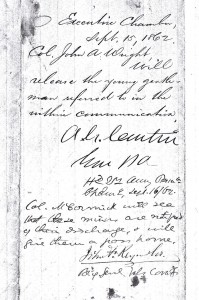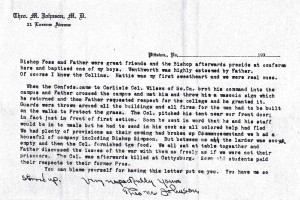My first visit to the Dickinson College Archives in the course of my research met with a good amount of success. The tales of A.G. Curtin’s release of soldiers and Deems’ request to a Confederate officer have been made much clearer now that I have read many of the primary sources. Specifically, minutes from a meeting of the College’s trustees from June 24, 1863 confirmed the anecdote stating that Dickinson students in the service of the Union Army were released from service and returned to school.
Once I had validated this story, I was interested in understanding the motivation behind the students’ release. A closer reading of the minutes revealed that the college sent a request for their release that was obliged by the Governor. After confirming my facts, I wanted to take the research a step further and see if the correspondence between the then-president of the college, H.M. Johnson, and Governor Curtin was still in existence. Fortunately, the College Archive had their original letters, and the order of release signed by the governor himself. The students that were released had enlisted to defend the
Pennsylvania border when Confederate invasion seemed imminent. Nearly all of these students were minors (15 or 16 years old) from other states and had neglected to inform their families of their enlistment. Without these students, the college could not remain open because of the expected neglecting of tuition payments. Therefore, H.M. Johnson appealed to Governor Curtin’s status as an alumni and asked that he take these factors into consideration and hasten the students’ return to campus. I plan to consult local newspapers and image collections to see if I am able to place more of a clear identity on these returned students and perhaps note any engagements they may have taken part in.
In the course of researching this information, I came across another letter in the archives’ card catalog. This letter, however, was written by the son of H.M. Johnson, Theodore. It was listed as containing information pertaining to the occupation of Carlisle and I figured that it would be worth reading to create historical context. In serendipitous fashion, the letter actually explained how the college was spared during the occupation. It fell into line
with my notion that the story of C.F. Deems was, in fact, apocryphal. According to Theodore Johnson, the college was spared because his father “threw” a masonic sign at the commander of the Confederate forces and the two initiated a mutually beneficial relationship in which the college was spared in exchange for supplies.
I plan to further my research through photographic archives to paint a clearer picture of who all of the aforementioned individuals were. I am particularly interested in the masonic Confederate colonel referred to as “Wilson,” and his role in the occupation. Also, I am asking myself if the students that went to fight actually engaged in any combat. I will attempt to determine this through resources and databases such as alumni records, newspapers and the American Civil War Research Database.
Sources:
Dickinson College Board of Trustees, Executive Committee. Minutes, 24 June 1863. Record Group 1/2, Board of Trustees (1833-1879), Archives and Special Collections, Dickinson College, Carlisle, PA.
H.M. Johnson, Carlisle to Governor A.G. Curtin, Harrisburg, 15 September, 1862. Record Group 2/6, Office of the President, H.M. Johnson, Archives and Special Collections, Dickinson College, Carlisle, PA.
Theodore M. Johnson, East Millsboro to James Henry Morgan, Carlisle, 20 February, 1933. Papers of James Henry Morgan, 1918-1928, Archives and Special Collections, Dickinson College, Carlisle, PA.



Excellent post. You should make this public.
Awesome. Going to the archives later this week. Hopefully I’ll get good results as well. Have to love when Masons pop up in American history.
i came across the same reference in a student paper. any luck on the masonic lead?
the only other reference i could find was also in a student paper. i have been pursuing other bits of information for the last few days, but i’ll let you know if anything pops up